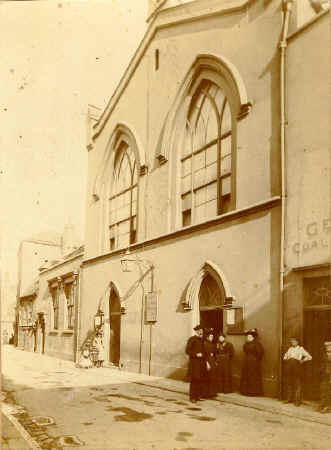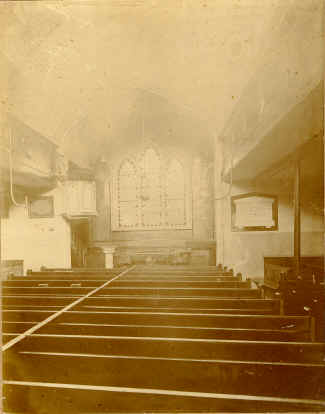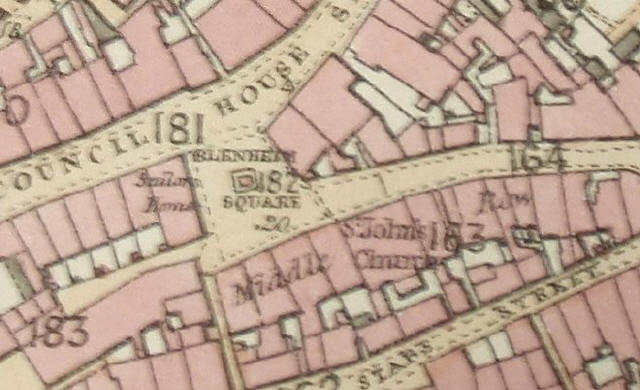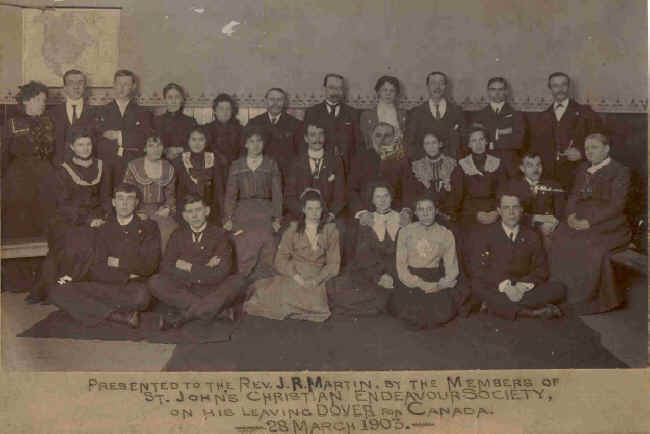| Back ... |
St. John Mariner |
|
|
|
||
|
||
 |
The church of St. John Mariner was originally erected in 1823 by Mr. Iggulden as a Wesleyan Chapel, for a congregation of dissenters. It afterwards passed into the hands of the Independents. It was situated in Middle Row, a small street leading off Blenheim Square in the Pier District. With seating for 500 persons, it was said to have accommodated "at a push, as many as one thousand persons". This whole area of Dover has long since vanished as a result of war damage and slum clearance. The pictures on this page were kindly loaned by Bill & Loraine Cairns in Canada. The man in the middle of this picture (left) with the beard is Bill's Grandfather, John Richard Martins. (Original pictures by J.G.Whorrel of Dover) |
|
|
The picture (right) shows the interior of the church, with the high pulpit, galleries and gas lighting. Behind the altar rail there are two chairs, but no altar is apparent. At the left end of the rail is the font; at the right end is a lectern. There is text visible in the arched frame to the left of the window, and in the panels below the window, but the picture is not clear enough to read what is says. The framed picture under the left balcony looks like a needlework sampler. In 1839, Reverend W.S.Cole, minister of nearby Trinity Church, rented the chapel to hold evening services until his own church was fitted out for the purpose. According to the New Dover Guide (1841), it was then an Episcopal chapel with Sunday evening services at 6.30.
|
 |
|
|
Reverend Yate founded the Dover Sailors' Home, with which the church became connected, and served as minister for 31 years. Reverend Yate died in 1877; his memorial tablet can be seen on the wall of the church, below the gallery on the right (picture above right). A number of my relatives (BEER, DIXON, HICKS, HOGBIN, MARSH, SAWYER, SHARP) were baptised at St John Mariner between October 1868 and April 1888. Some time after the death of Reverend Yate, it would appear that the church was taken over by the Temperance Movement, with John Martins as the new incumbent. He wrote in the family Bible "Rev. John Richard Martins of St. John's Church Dover - Kent England & 17 years Incumbent". His journal that he kept from April 1884 until January 1891 makes mention that he was with the Temperance Movement and worked at the Castle visiting the men in hospital and in their barracks and the married quarters. The photograph below bears the caption: PRESENTED TO THE REV. J.R.MARTIN, BY THE MEMBERS OF
|
||
|
|
||
|
The church fell into disuse after about 1900. It was described by Messrs Worsfold and Hayward, auctioneers, as being "in excellent condition" when it came under the hammer in 1908. The organ was sold separately at the same auction for £52; the price fetched by the building is not recorded.
|
||
|
Information on this page extracted from John
Bavington Jones' Perambulation
of Dover (1907) and the New Dover Guide (1841).
|
||
|
Page last updated 02/02/2008 |
||

